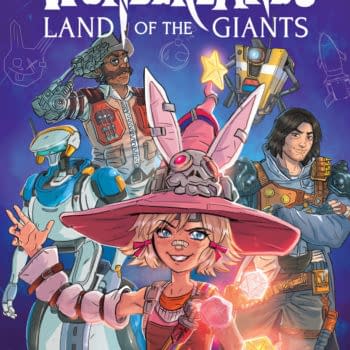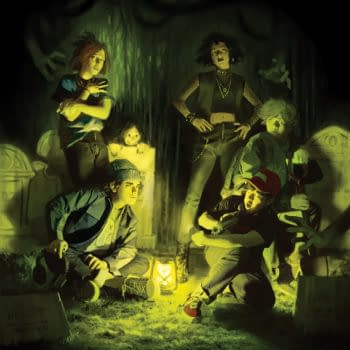Posted in: Comics, Recent Updates | Tagged: Adventure Time: Marceline Gone Adrift #1-2, boom studios, Captain Marvel #12, Comics, Darth Vader #1, Divinity #1, entertainment, Marvel Comics, Q2: The Returns of Quantum & Woody #1-5, valiant comics
Thor's Comic Review Column – Q2: The Returns of Quantum & Woody #1-5, Darth Vader #1, Adventure Time: Marceline Gone Adrift #1-2, Divinity #1, Captain Marvel #12
This Week's Reviews Include:
Q2: The Return of Quantum and Woody #1-5
Darth Vader #1
Adventure Time – Marceline Gone Adrift #1 & #2
Divinity #1
Captain Marvel #12
Q2: The Return of Quantum and Woody #1-5 (Valiant, $3.99)
by Graig Kent
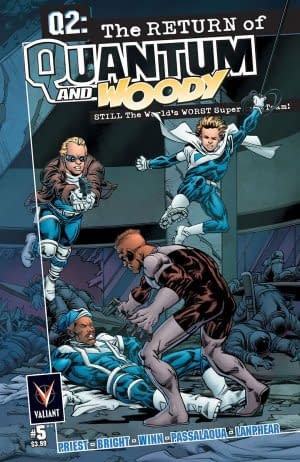
Priest's departure from comics should have rocked fandom, he's easily on the same level as editor-to-writer peers like Kurt Busiek and Mark Waid (could you imagine if Waid or Busiek declared they were quitting?) but he's never seen the same opportunities they have, and it's hard to say race wasn't a factor. Oh it's not the only factor, but when he was constantly handed characters (The Ray, Triumph) and titles (Justice League Task Force, The Crew) that the publishers do little to support he was never going to earn the cache to take over the Avengers or Superman.
His biggest successes came at about the same time in 1998, with his character-defining/revitalizing run on Black Panther over 60-issues at Marvel, and the creation of Quantum and Woody at Valiant, running until the company folded in 2000. I was in a comics lull at the time managed to miss out on both series, and the shoddy availability of reprints or collections (criminally only the first dozen or so issues of Panther have been reprinted in trades) have made it hard to catch up. Finding complete runs of either title has proven a chore. So I came at Q2 with virtually fresh eyes and limited experience with the characters, but eager to throw my support behind Priest and collaborator/co-creator MD Bright. The legacy Q&W left on the community wasn't short-lived. It was quite readily identified as the crown jewel of Valiant's publishing output, it's mix of social and political commentary with superheroes and comedy was certainly not something regularly seen in the mainstream. A return to the original characters by the original creators had much to live up to.
My first impression of Q2 was, quite frankly, confusion. Priest's first issue is dense, beginning with a flashback to the lead characters' teenage years where Woody shoots a man in the head before thrusting us into a modern day setting where Quantum and Woody are estranged and there's a new duo wearing their uniforms. I felt, at first, like I had missed something. Not just something, many things. References and characters seemed to make no sense, and understanding the relationship dynamics or the timeframe everything was happening in bordered on laborious.
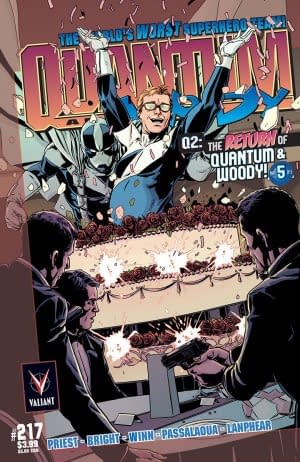
Priest wasn't coming back to Quantum and Woody to relive the glory days nor was he just going to fanservice the characters with lots of Goat and goofballs. Instead he crafted a dense and serpentine narrative that introduces a some new characters, redefines the old ones in a new context, and rebuilds their entire world. It's not the most new-reader friendly, not at first, as there is an assumption early on that you are familiar with the dynamic of Eric Henderson and Woody Van Chelton and are game for Priest's distinct storytelling structure (co-opted by James Asmus for the modern Quantum and Woody but not nearly as effectively used), but at the same time it does eventually deliver these characters to you as a whole, and any reader should be able to catch up.
By the end of the fifth issue, Priest and Bright had delivered a book that is often touching, exciting, and funny, with at least three mysteries simultaneous posed, connected and resolved, while concluding the book by opening the back-door to the possibility of more. The middle issues (2-4) charmingly also feature a few pages of covers for issues of the original series that never existed (#95, 97, 118, 130, and 153) , but really should have.
Perhaps Priest's greatest triumph, and his greatest strength as a writer, is his commitment to diversity without making a point of it. The new Woody, appearing to be a teenaged boy, actually self-identifies as female. It a reveal made casual, without any fanfare, and the elder Woody deals with it the same way he deals with everything else, with mildly inappropriate remarks, which makes it fit naturally with the overall tone of the book. That reveal, by the way, is the least surprising thing about the new Woody, as there's two other reveals that completely recontextualize the character in a very short period of time. Priest is an absolute master at this form of character depth and development, and a decade out of the comics game he still does it with relative ease.
What seemed like a rocky start it turns out was mastercraft, and I'm as impressed with Priest as I ever was. I lament his absence from comics even more with the conclusion of this mini. At the very least, I'm hoping for another go-around with Priest, Bright and Quantum and Woody sooner rather than later, and hopefully another batch of those "what if…" covers.
Graig Kent is so very tired, and mildly envious of so many people, and a little tipsy right now. He writes about movies and TV sometimes at wedisagree.blogspot.com and his first novel, Quarter City, can be read for free on Wattpad at the moment.
Darth Vader #1 (Marvel, $4.99)
By Cat Taylor
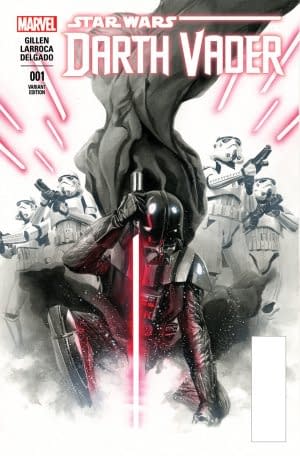
How the first issue of Darth Vader succeeds where many other Star Wars comics just get by or outright fail, is by exploring the low-hanging fruit at the end of the original Star Wars movie. There were some obvious threads left to be untangled such as the repercussions to Vader for his inability to keep a group of rag-tag rebels from destroying the Emperor's prized Death Star.
Keiron Gillen is a well-established Marvel writer who not only explores obvious loose ends from the first movie, but also fills in gaps that explain the backstory behind some of the events in Empire Strikes Back, and examines the psyche of a pretty messed up Darth Vader and his increasingly tense relationship with the Emperor. In addition to being a well-written story that logically fills the aftermath of the first movie, an expanded universe story needs to "feel" like the original property. Sometimes this area has been cause for disappointment in other Star Wars comics as well. For instance, a lot of the previous between movie stories simply focused on the characters pursuing unwritten missions. However, Gillen truly ties his story to events of the movies.
The only time that the story really threw me was in a montage of flashback scenes. I recognized most of them from the movie but there was one scene that never happened. At first, I thought maybe I misunderstood the time period of the comic and it was actually taking place after Empire Strikes Back and the scene was being recreated with extreme artistic license. However, that was not the case. It was merely a flashback to the first issue of the new Star Wars comic. It was a bit confusing since I hadn't read that issue but I got it sorted out.
Another important factor in making a comic book tie-in "feel" canonical is making sure the artist can capture the look of the characters and the atmosphere of the surroundings. Long-time Marvel artist, Salvador Larroca, mostly achieves this feat. He definitely captures the look of the characters but does so in a clean linear style rather than by attempting photo-realism. In addition to capturing the look of the characters, Larroca also effectively conveys the power of Vader early in the story by showing him effortlessly dispatching a multitude of ruffians in Jabba the Hutt's palace. Most artists would show this scene in great detail, emphasizing the graphic violence caused by Vader in order to show how badass he is. Larroca, on the other hand, takes almost the exact opposite approach. He depicts much of the action in extreme close-up that obscures a lot of the detail, but what he shows of Vader in these moments is a man who barely has to lift a finger and still manages to cause more damage with the casual flick of his light saber than Hulk could cause using his full strength to swing a car like a baseball bat.
Furthermore, the letterer, VC's Joe Caramanga opens this issue with the all-important black splash page that simply includes the phrase, "A long time ago in a galaxy far, far away…", and on the next two-page spread over a background of stars, "STAR WARS – DARTH VADER," then on the fourth page, the legendary prelude text crawl. Whether in a movie or a comic book, a lot can be forgiven by setting the appropriate mood with such iconic elements.
On the other hand, if there's anywhere that the art doesn't quite feel like Star Wars, it's in the colors from Edgar Delgado. Even though he seems to use the right amount of light and shadow for the appropriate environments, something about his colors overall just seemed too bright. I remember seeing some "behind the scenes" documentaries on the making of Star Wars where George Lucas discussed how they made the ships and vehicles look used and intentionally put some damage on them rather than having everything clean and perfect. I think that's why the colors in this issue don't quite capture the feeling of the movies. They're just too bright and shiny.
After reading this issue, I'm surprised that the new Star Wars flagship title was so disappointing to so many people. This issue of Darth Vader really nails everything just right. Perhaps Marvel needs to switch Gillen over to the main book, or maybe Vader is just such a cool character that he's a lot easier to write. My only reservation with the new Star Wars comics at this point is that they are already starting out with too many. There's simply no way I'm going to buy four or more Star Wars titles every month. Even if they were all as good as this issue, the time and financial commitment is just too much. Plus, when publishers spread things too thin, they run out of good ideas much more quickly and the quality inevitably suffers. I'd prefer to see Star Wars comics that are few and far between. Maybe a series of mini-series published only when a writer has a really good story to tell. I really can't imagine that four or more ongoing monthly titles are going to stand the test of time and therefore, the product will once again become diluted. With such a strong start, I really hate to see that happen, but I'd be willing to bet my complete collection of the original Marvel Star Wars comics that it will.
Cat Taylor has been reading comics since the 1970s. Some of his favorite writers are Alan Moore, Neil Gaiman, Peter Bagge, and Kurt Busiek. Prior to writing about comics, Taylor performed in punk rock bands and on the outlaw professional wrestling circuit. During that time he also wrote for music and pro wrestling fanzines. Taylor is currently experiencing a mid-life crisis and is forming a new group that combines his past in punk rock bands with his past in professional wrestling. You can e-mail Cat at cizattaylor@hotmail.com.
Adventure Time – Marceline Gone Adrift #1 & #2 (Boom! Studios)
By Adam X. Smith
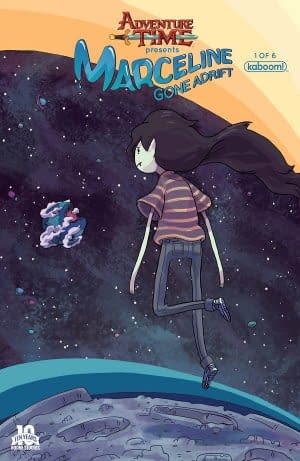
In principle, Adventure Time is the last thing I would expect to spark my intrigue: the humor is random and surreal but without the biting archness that made the likes of The Mighty Boosh must watches for me back in the day, and its almost ready-made hipster appeal made me shy from it like Dracula from garlic bread. But something about the pastel shaded Land of Ooo and Pendleton Ward and company's cast of bizarre characters makes it fundamentally endearing on a subconscious level – perhaps it's the series' mish-mash of Frank Frazetta epic storytelling and Tim Schaffer quirkiness, I'm not sure.
So when I heard that BOOM! Studios' all-ages imprint KaBOOM! were doing a second miniseries focusing on Marceline the Vampire Queen, I thought it would be a good opportunity to make the move from casual toe-dipping to actively giving the series (or at least the spin-off comics) a day in court. And since I currently lack any kind of funds for the interim and BOOM! obligingly gives us lots of free digital comics to review, there's no comics like free comics.
Following on from the events of KaBOOM!'s first foray into Adventure Time comics, "Marceline And The Scream Queens", Marceline is currently suffering from a musical writer's block and wishes to gain new experiences to reinvigorate her muse. No sooner than she wishes this than she is overcome with mystical energy. In trying to save both Ooo and Marceline from the chaos created, Princess Bubblegum accidentally propels Marceline into the farthest reaches of space whilst simultaneously stripping her of her powers. Overcome with guilt, Princess Bubblegum resolves to travel into space, rescue Marceline and bring her home.
Whilst that one-paragraph summary shows that the series is relatively light on plot at the moment, returning writer Meredith Gran and new recruit artist Carey Pietsch manage to imbue the writing and artwork with just enough of the show's distinct flavor to appeal to the core audience of Adventure Time fans whilst keeping the plot and dialogue straightforward enough for Johnny-Come-Latelys like myself to be able to pick up relatively quickly in one sitting. What's probably going to decide whether this holds my attention or not is whether the next issues manage to course-correct the slightly glacial pacing of issue #2 and show us what is lurking out there in the blackness of space that could possibly be more terrifying than Marceline on a bad day.
Whilst I'm by no means a full-on convert based on two issues in isolation, there's enough interest in the series left in the tank for me to continue reading the full six issues. For heavy-duty fans of the series it might be a little bit light on action for 4 bucks, but as freebies go, I've read a hell of a lot worse.
Adam X. Smith is a pale imitator of a boy in the sky, with a cap in his head and a knot in his tie.
Divinity #1 ($3.99, Valiant)
By D.S. Randlett (@dsrandlett)
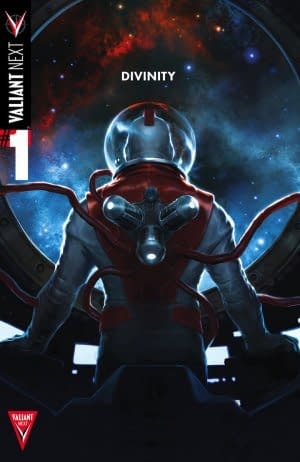
Divinity wears its Moore influence on its sleeve, from the Doctor Manhattan-esque protagonist to the way Kindt structures the narrative. There's a recurring idea of moments in this issue, with the omniscient narrator making constantly making references to the turning pages of a book. While not as rigidly structured as Fearful Symmetry, there are similar ideas at play. The form of the comic book is, within this story, how the infinite is perceived, with certain moments locked into place where a reader, of a young god, can flit between certain moments at will. What this issue is very good at is bringing the reader into a strange vision, and Kindt has learned his lessons from Moore well in this regard. It differs from Moore in the sense of decompression. For all of his introspection, Moore's work is often narratively packed, and that is, unfortunately, not the case here. While this does preserve a sense of mystery, it also contributes to a feeling of not much happening.
Hairsine's art gets the job done, with certain moments standing out more than others. He excels at showing the detachment of the story's newly minted godling in the books' final moments, and the few moments of the weird are very well realized. Some of the smaller moments lack impact, however.
All in all, Divinity has a promising start, but in light of science fiction work like Lemire's Trillium, it doesn't feel as bold or as confident as it maybe should.
D.S. Randlett lives in the hills of Virginia and takes credit for the reviews that his emaciated twin brother writes while chained to the old radiator. He plays his guitar while biding his time for unsuspecting tourists and thinking about going to grad school.
Captain Marvel #12 (Marvel, $3.99)
By Jeb D.
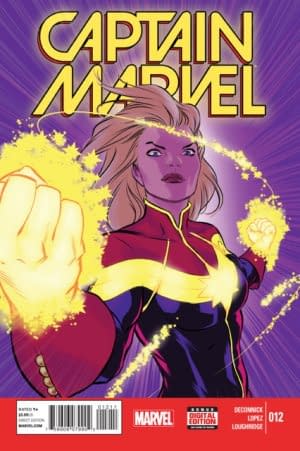
I don't want to give the wrong impression: I'm still a big fan of Kelly Sue DeConnick's writing and character work; but I can't help thinking that the status quo, with Carol Danvers as the Avengers' outer space ambassador/troubleshooter, is getting in her way. DeConnick's first Captain Marvel volume, with characters like Helen Cobb and the Banshee Squad, and storylines like the disease that kept Carol grounded, were more compelling than the space opera stuff.
We saw hints of a return to that with the more Earthbound holiday-themed two-parter in issues 10 and 11, but #12 begins with Carol being returned to her ship, only to find that it's been devastated by a space-pirate attack while she was gone. Within those limitations, this is a pretty strong issue: it's mostly just Carol, alone in her crippled ship, facing down the threat of the Haffensye pirates who, in Carol's absence, have abducted Tic and Chewie. It's the kind of setup that the various Star Trek TV series have used to good effect, and I suspect this is where Ellis has chimed in, adding details like dark matter and the space-time enigma called the "Endless Envelope," that help to open up the scope of an issue where Carols spends most of her time floating in zero gravity, pushing buttons, and bantering with her A.I. Harrison (who coolly informs Carol that he'd be inclined to laugh now and again if he realized she was trying to be funny). There's also a very funny sequence that suggests that here on Earth isn't the only place we have to deal with crappy phone coverage.
Space opera may not play to DeConnick's strengths, but artist David Lopez (with fantastic color work from Lee Loughridge) continues to be a big upgrade for this series, and his imaginative work is vital to the pacing: the paneling of Carol's attempts to restore her ship before it's too late are urgent and angular, and he nails the point where Carol's headlong rush gives way to awe at the sight of the Endless Envelope. He also does a nice job using Carol's hair like a superhero cape reflecting its wearer's mood: it streams uncontrollably as she struggles in zero-g, then settles smoothly back to her shoulders as she regains her composure and confidence, setting off to rescue her friends.
Obviously, anyone fond of well-written, character-driven space opera should eat this up, and having Ellis along for the ride is a nice bonus. But those of us who are maybe just a tad burned out on spaceships and aliens will continue to hope that DeConnick, Lopez, and/or Ellis, can bring Carol back down to earth sooner rather than later.
Jeb D. is looking forward to seeing The Love Me Nots at San Francisco's Elbo Room this week, and will gladly buy a round if you're there.














